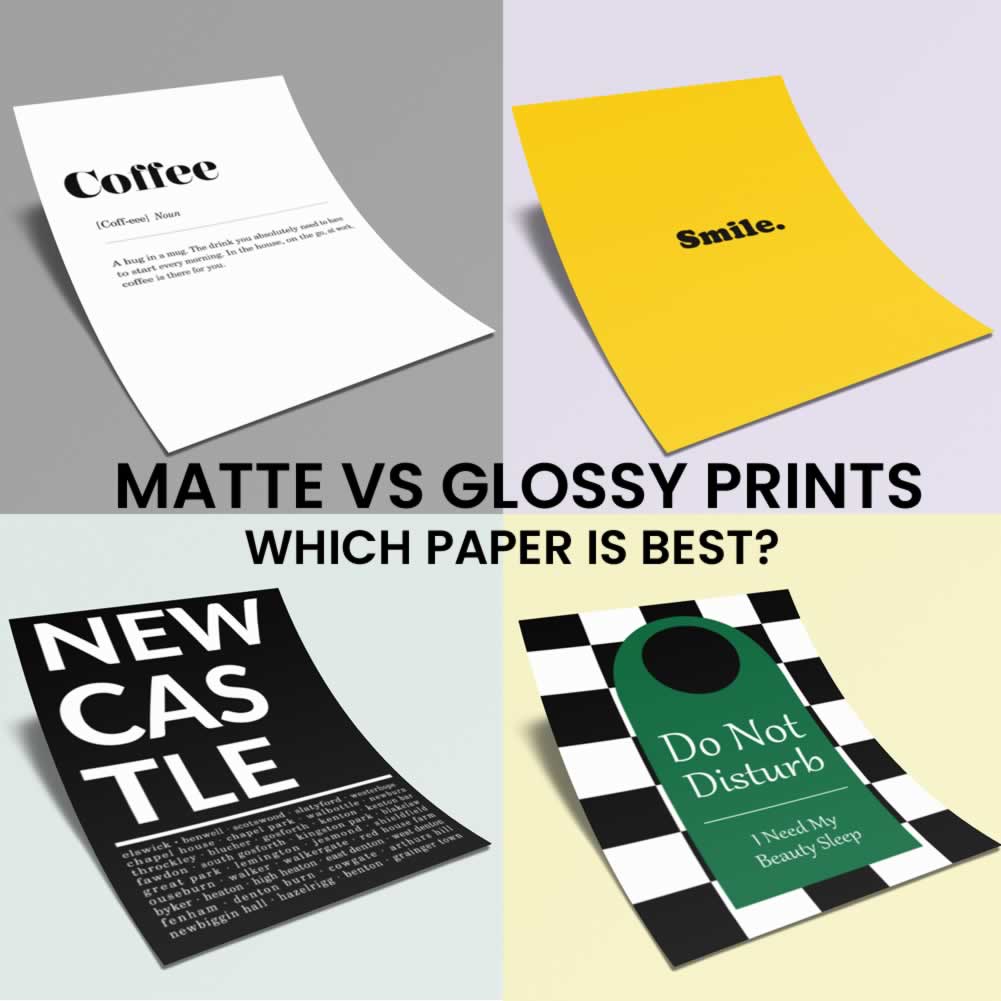When it comes to printing your artwork, the choice between matte and glossy finishes can significantly impact the final presentation.
Both finishes have their unique qualities, making them suitable for different types of art and preferences.
With lots of options available for art prints, matte and glossy are two of the most popular.
So which is best for your prints, and what's the differences anyway?
Let's take a look.
Understanding Matte and Glossy Art Prints
Before diving into the pros and cons, it’s important to understand what distinguishes matte and glossy art prints from each other.
The finish of your print affects not only the visual appeal but also the durability and overall experience of the artwork.
What Are Matte Art Prints?

Matte art prints have a non-reflective finish, which means they do not have the shine that is characteristic of glossy prints.
The matte surface is smooth and diffuses light, which helps reduce glare and makes the artwork easier to view from different angles.
This finish is often preferred for its subtle and sophisticated appearance.
What Are Glossy Art Prints?

Glossy art prints, on the other hand, have a shiny, reflective surface that enhances the vibrancy and sharpness of colours.
The glossy finish gives prints a polished, high-contrast look that makes colours pop and details stand out.
This type of finish is popular for photographic prints and artwork that benefits from a bold, eye-catching presentation.
Pros and Cons of Matte Art Prints
Matte art prints offer a unique set of advantages, particularly for certain types of artwork. However, they also have some limitations that might influence your decision.
Pros of Matte Art Prints
- Non-Reflective Surface: Matte prints do not reflect light, making them ideal for viewing in any lighting condition. This makes them particularly suited for display in well-lit rooms or galleries.
- Subtle, Elegant Finish: The lack of shine gives matte prints a more understated and sophisticated look, which is often preferred for fine art reproductions and black-and-white photography.
- Minimal Fingerprints: The matte surface is less likely to show fingerprints, smudges, or scratches, making it easier to handle and maintain.
- Reduced Glare: With a matte finish, glare is significantly reduced, ensuring that the artwork can be viewed clearly from any angle.
Cons of Matte Art Prints
- Less Vibrant Colours: Matte prints tend to absorb more ink, which can slightly dull the colours compared to glossy prints. This might not be ideal for artworks that rely on bold, vibrant hues.
- Lower Contrast: The soft, diffused finish of matte prints can result in lower contrast, making them less suitable for highly detailed or contrast-rich images.
- Limited Depth: Matte prints may lack the depth and intensity that glossy finishes provide, which can be a drawback for certain types of artwork.
Pros and Cons of Glossy Art Prints
Glossy art prints are known for their vibrant and dynamic appearance, but they come with their own set of considerations.
Pros of Glossy Art Prints
- Vivid Colours: The glossy finish enhances colour saturation, making prints appear more vibrant and lifelike. This is especially beneficial for photographic prints and colourful artworks.
- High Contrast: Glossy prints provide excellent contrast, which helps to bring out details and make images appear sharper and more defined.
- Professional, Polished Look: The shine of a glossy print gives artwork a sleek, modern appearance, making it a popular choice for commercial prints and portfolios.
- Enhanced Depth: The reflective surface of glossy prints can add a sense of depth, making the artwork feel more immersive and dynamic.
Cons of Glossy Art Prints
- Reflective Surface: The main drawback of glossy prints is their reflective nature, which can create glare in certain lighting conditions. This can make the artwork difficult to view from certain angles.
- Shows Fingerprints and Smudges: The shiny surface is more prone to showing fingerprints, smudges, and scratches, requiring careful handling and possibly more frequent cleaning.
- Glare Behind Glass: When framed behind glass, the glare can be even more pronounced, potentially detracting from the viewing experience.
Which Is Best for Your Art Prints?
Choosing between matte and glossy finishes ultimately depends on the type of artwork, the intended display environment, and personal preferences.
Here are some considerations to help you make the right choice:
For Fine Art Prints
Matte Finish: If your artwork is a fine art piece, particularly one with a lot of subtle tones or textures, a matte finish might be the better option.
The non-reflective surface will allow viewers to appreciate the intricate details without the distraction of glare.
Glossy Finish: If your fine art piece is vibrant and relies on strong colour contrast, a glossy finish can enhance these qualities, giving the print a more dynamic presence.
We'd go with matte for fine art prints, and use a giclee printing process for the ultimate art piece.
For Photography
Matte Finish: Black-and-white photographs and images with softer tones often look stunning on matte paper.
The lack of shine allows the viewer to focus on the details and emotions conveyed in the image.
Glossy Finish: Colour photographs, especially those with bright, bold colours or high contrast, typically benefit from a glossy finish.
The enhanced saturation and sharpness can make the photo appear more vivid and striking.
For Display Conditions
Matte Finish: If the artwork will be displayed in a brightly lit area, a matte finish is preferable as it reduces glare and makes the print easier to view from all angles.
Glossy Finish: In controlled lighting environments, such as galleries or exhibitions with subdued lighting, glossy prints can be an excellent choice. The controlled lighting will minimise reflections while enhancing the print’s vibrancy.
Other Considerations
Framing
When it comes to framing your art prints, consider how the finish will interact with the glass or acrylic used in the frame.
Glossy prints may reflect more when placed behind glass, potentially diminishing the viewing experience.
In contrast, matte prints generally pair well with glass or acrylic, as they are less prone to glare.
Handling and Maintenance
If you plan to handle your prints frequently, a matte finish may be more practical due to its resistance to fingerprints and smudges.
Glossy prints, while visually stunning, require more careful handling to maintain their pristine appearance.
Personal Preference
Ultimately, personal preference plays a significant role in choosing between matte and glossy prints.
Some people prefer the subtlety and elegance of matte finishes, while others are drawn to the boldness and depth provided by glossy prints.
Consider what appeals to you most and how you want your artwork to be perceived.
Other Options
There are other options available for paper choices, including semi glossy also know as satin paper. Learn about the different art papers which are available to get the best results for your work.
On That Note
The choice between matte and glossy art prints is a matter of balancing aesthetics, practicality, and the specific needs of your artwork.
Matte prints offer a sophisticated, non-reflective finish that is ideal for fine art and photography where subtlety and detail are key.
Glossy prints, with their vibrant colours and high contrast, are perfect for making a bold statement and showcasing photographic works.
By understanding the pros and cons of each finish and considering factors like the type of artwork, display environment, and personal preference, you can make an informed decision that enhances the beauty and impact of your art prints.




